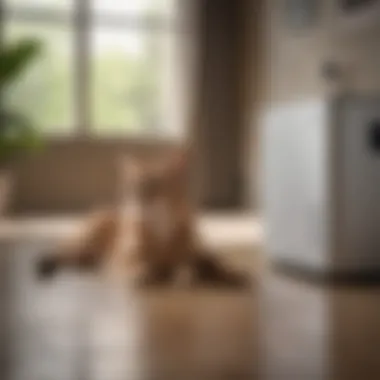Top HEPA Air Purifiers for Cat Allergy Relief


Intro
When it comes to shared spaces with our furry companions, cat allergies can often become an uncomfortable reality for many households. With the droves of dander and pollen brought in from outdoors, those sneezes and itchy eyes can hit hard, affecting not just allergenic individuals but the entire family. Tailored solutions like HEPA air purifiers have become a beacon of hope for those seeking to improve their indoor air quality. This article dives deep into understanding how these devices operate, the characteristics that make them suitable for alleviating cat allergies, and critical aspects to consider if you’re on a quest for the most effective air purifier.
Understanding Cat Allergies
Cat allergies stem from proteins found in cat saliva, skin, and urine. When cats groom themselves, they spread these proteins around their environment, creating a dust that is easily inhaled. Symptoms may vary from person to person, ranging from sneezing and coughing to skin rashes. Grasping these allergic triggers is crucial for picking the right air purifier.
Features of HEPA Air Purifiers
HEPA, which stands for High-Efficiency Particulate Air, is designed to capture at least 99.97% of particles that are 0.3 microns in size. This remarkable capability makes HEPA filters an indispensable ally for allergy sufferers. Here are some key features to consider:
- Filtration Mechanism: HEPA air purifiers trap allergens through a series of fibers that create a dense mat. Such structure ensures maximum weight and size of particles are captured rather than passed through.
- CADR Ratings: Clean Air Delivery Rate (CADR) measures how quickly an air purifier can filter air in terms of smoke, dust, and pollen. Higher numbers mean more efficient purification.
- Noise Levels: Many air purifiers operate at a range of volumes. Look for models with a noise level that matches your preference.
"Understanding how HEPA technology works is key to making informed choices when managing allergies."
Top HEPA Air Purifier Choices for Cat Allergy Relief
- Dyson Pure Cool™ TP01: This purifier not only filters out pet allergens but also cools the air, making it a multifunctional choice. With a sleek design and WiFi connectivity, it offers easy monitoring via a smartphone app.
- Honeywell HPA300: Known for its strong CADR rating, the Honeywell HPA300 is effective in larger spaces. Its True HEPA filtration ensures that cat allergens are efficiently removed from the air.
- Levoit LV-32: A budget-friendly option, this purifier is compact yet powerful and features a three-stage filtration system, catering specifically to pet owners.
Essential Considerations When Choosing an Air Purifier
When selecting an air purifier for relief from cat allergies, keep these factors in mind:
- Room Size: Ensure the purifier is suitable for the size of the space. Larger rooms may necessitate a more powerful unit.
- Filter Maintenance: Look for units with easy-to-replace filters, as regular maintenance is vital for effective performance.
- Additional Features: Some models offer features like air quality indicators or multiple fan speeds, which can enhance usability.
Tips for Creating a Healthier Indoor Environment
While selecting an air purifier is crucial, adopting other measures is equally important:
- Regular Cleaning: Dust and vacuum frequently using HEPA-equipped vacuums to decrease allergen buildup.
- Limit Pet Access: Designate pet-free zones in your home, such as bedrooms.
- Maintain Humidity Levels: Humidity can influence dust mite populations. Aim to keep indoor humidity between 30-50%.
End
Intro to Cat Allergies
Cat allergies can leave individuals feeling like they are trapped in a room with no escape. The constant sneezing, itchy eyes, and skin rashes can wreak havoc on one's daily life. In this article, we will delve into the intricacies of cat allergies, understanding their causes and symptoms, and why exploring air purifier options can play a pivotal role in managing these allergic responses.
Understanding the Causes of Cat Allergies
It's often said, "It’s not the fur, it's what's in the fur" when it comes to cat allergies. Most folks don't realize that the root of their allergy symptoms is typically not the cat's fur itself but the proteins found in their saliva, urine, and dander. These proteins, specifically Fel d 1, have a sneaky way of becoming airborne, hitching a ride on dust particles or simply floating around the living space.
Did you know that cat allergens can linger in the air long after the cat has left the room? It's like a ghost you just can't shake off. The impact of these allergens varies from person to person; some might experience mild reactions, while others could find themselves in a full-blown allergic attack. It’s essential to recognize these triggers, making preventive strategies necessary for anyone living with or around cats.
Common Symptoms of Cat Allergies
If you've ever found yourself reaching for tissues after cuddling your feline friend, you might be all too familiar with the symptoms associated with cat allergies. Some common reactions include:
- Sneezing and nasal congestion: A classic sign that your body is reacting to allergens.
- Itchy, watery eyes: This may feel like having a bad day at the pollen park.
- Coughing or wheezing: Especially for those already prone to respiratory issues, this can stir up quite the stir.
- Skin irritations: Rashes or hives can surface after contact with a cat, causing discomfort and frustration.
- Migraine-like headaches: Some people experience tension and headaches as a secondary reaction to allergens.
"Allergic rhinitis, commonly known as hay fever, is a classic indicator of allergies, and cat allergens can trigger this reaction considerably."


Understanding these symptoms is crucial not just for those with allergies but for their feline companions as well. Awareness paves the way for prevention, emphasizes the need for effective air purification solutions, and ultimately, enhances the quality of life for everyone involved.
By becoming educated about cat allergies, readers can better navigate their homes and environments, seeking out top-tier air purifying technologies to keep those pesky allergens in check.
The Importance of Air Quality in Allergy Management
Understanding air quality is crucial when it comes to managing allergies, particularly for those who share their space with cats. These furry companions can be sources of allergens that impact both pets and owners alike. Focusing on enhancing indoor air quality paves the way for alleviating allergic reactions and creating a more comfortable living atmosphere.
How Indoor Air Quality Affects Health
Air quality is more than just a buzzword; it plays a pivotal role in our overall health. Poor air quality can lead to problems such as headaches, fatigue, and respiratory issues, making it essential to keep tabs on what floats around in your home environment.
When we talk about allergens, we're not just looking at fluffy cat fur. Dander and saliva, for instance, contain proteins that can easily become airborne, triggering allergic reactions. Furthermore, if these allergens are not effectively filtered from the air, they can settle into carpets and furniture, creating long-lasting issues.
A study I came across indicated that individuals with asthma or other respiratory conditions can experience exacerbated symptoms in spaces with higher concentrations of allergens. This is where HEPA air purifiers come into play, working steadily to capture these particles before they can do any harm.
"Clean air is not just an amenity; it’s a necessity for those who suffer from allergies."
Role of Allergens in Indoor Environments
Allergens are uninvited guests in our homes, often making themselves quite at home without permission. Dust mites, mold, and pet hair are common culprits that float around. However, in homes with cats, cat dander poses a unique challenge. The proteins found in cat dander can remain airborne longer than one might expect, which means they require consistent and effective air filtration methods to minimize their presence.
Here are some key points about allergens and their contribution to indoor poor air quality:
- Small Size: Many allergens, including pet dander, are small enough to evade standard filters and settle deep in our breathing zones.
- Long Lifecycle: Some allergens, like dust mites, thrive in fabrics and soft surfaces. They reproduce quickly and can create persistent allergy issues if left unchecked.
- Cumulative Effects: Often, the effects of allergens are not immediate but accumulate over time. Even low levels of exposure can lead to significant discomfort if not addressed.
In short, managing indoor air quality is vital. The inclusion of HEPA air purifiers is a piece of the puzzle that can go a long way in ensuring that our homes remain an oasis instead of a battleground for allergies. Proper maintenance and an understanding of the various aspects of indoor air quality can bring relief to those persistently bothered by cat allergies.
What is a HEPA Air Purifier?
A HEPA air purifier is an essential tool when it comes to managing indoor air quality, especially for those sensitive to allergens, such as cat dander. HEPA stands for High-Efficiency Particulate Air, and what sets these purifiers apart is their ability to capture particles as small as 0.3 microns with a high degree of efficiency. This is critical for allergy sufferers, as many allergens tend to be in that size range. Understanding the workings of a HEPA air purifier is vital for making an informed decision about which model might be most beneficial for your home environment.
Mechanics of HEPA Filtration
At its core, HEPA filtration operates on three main principles: interception, inertial impaction, and diffusion. These processes work together to ensure that small particles are trapped rather than recirculated back into the air.
- Interception: As air passes through the filter, particles come near the filter fibers and stick to them, thereby reducing airborne allergens.
- Inertial Impaction: Larger particles do not follow the airflow smoothly; they collide with the fibers due to their mass and get stuck.
- Diffusion: Smaller particles that are usually too light to settle follow a more erratic path and, through random motion, increase the chances of hitting a fiber and being captured.
This combination of methods allows HEPA filters to boast a 99.97% efficiency rating, making them particularly effective against pet dander, dust mites, pollen, and other common allergens tied to cats.
Benefits of Using HEPA Filters for Allergy Relief
Utilizing a HEPA air purifier offers multiple advantages, particularly for those with cat-induced allergies. Some notable benefits include:
- Effective Allergen Removal: HEPA filters excel in trapping airborne cat allergens, which can significantly reduce symptoms like sneezing, itchy eyes, and nasal congestion.
- Improved Overall Air Quality: By continuously removing particulate matter, these purifiers enhance the overall indoor environment, making it more comfortable for both humans and pets.
- Reduced Odors: While HEPA filters are great for particles, many purifiers also contain activated charcoal filters that can take care of odors associated with pet ownership.
- Healthier Breathing Space: Clean air may reduce the frequency of respiratory problems, making it safer for family members and fostering a healthier home.
- Customization and Versatility: There are various models available, allowing users to choose based on room size, filter types, and additional features, thus catering to unique needs.
"Investing in a HEPA air purifier can be a game changer for allergy sufferers, transforming your living space into a more breathable sanctuary."
In summary, the importance of understanding HEPA air purifiers transcends mere knowledge about their function; it is about fostering a healthier living environment. For cat owners particularly, these devices can play a pivotal role in managing allergies, allowing for a cohabitation that suits both pets and their human companions.
Top HEPA Air Purifiers for Cat Allergies


When it comes to managing cat allergies, the role of air purifiers cannot be overstated. Allergens from our furry friends can float around our homes, making life challenging for anyone prone to hypersensitivity or respiratory issues. A HEPA air purifier stands out as a crucial tool, designed specifically to capture those pesky particles that trigger allergic reactions. By filtering out pet dander, saliva, and even the smallest dust mites, these devices can substantially improve the quality of the air in your home, providing significant relief to cat lovers.
Comparison of Leading Models
The market is flooded with various models of HEPA air purifiers, each boasting unique features and capabilities. When comparing these leading models, it’s imperative to focus on aspects like CADR ratings, filter efficiency, noise level, and room coverage. Some purifiers may excel in one category but falter in another; understanding these nuances can guide you toward a well-suited choice for your home.
Consider the Honeywell HPA300: renowned for its high Clean Air Delivery Rate (CADR) which ensures the air circulates effectively in larger spaces. Alternatively, the Dyson Pure Cool offers a blend of purifying filtration and a fan, providing a distinct option to improve air circulation while also having an aesthetic appeal.
Detailed Reviews of Selected Purifiers
Model Specifications
In this section, the specifics of each chosen model come into play. Take for instance the Levoit Core 300. Its compact design doesn’t compromise on functionality. Featuring a true HEPA filter, it is particularly efficient at trapping airborne allergens, which is pivotal for anyone dealing with cat allergies. The sleek size also makes it easy to fit into any corner of your living room or bedroom.
An important aspect here is the filter longevity; the Levoit Core 300 often lasts for around 6-8 months before needing a replacement, which is beneficial for a busy household.
Performance Metrics
When assessing performance, CADR (Clean Air Delivery Rate) serves as a vital benchmark. For instance, the Coway AP-1512HH consistently scores high in CADR testing when compared with other models. Specifically tailored filtration technology enables it to tackle pet dander and other allergens efficiently. It operates at varied speeds depending on the room's air quality, ensuring an optimal balance between noise and performance.
This adaptable function means that during quieter hours, the purifier can run slower, minimizing distractions while still maintaining clean air.
User Feedback
User reviews often provide insight that technical specifications may not convey entirely. The Germguardian AC4825 receives praise for its ability to reduce allergy symptoms almost immediately upon setup. Users highlight the ease of filter replacement and overall maintenance. However, some have noted that the noise level, while manageable, can be noticeable on higher settings. This indicates that balancing performance with user experience is crucial, especially in shared living spaces.
Additionally, user feedback often emphasizes the importance of size; smaller units like the Germguardian are more suited for bedrooms, whereas larger purifiers like the Honeywell HPA300 are favoured for open-plan living areas.
Key Features to Consider When Choosing a HEPA Air Purifier
Selecting the right HEPA air purifier can feel overwhelming, but understanding a few key features makes the process clearer. Each detail can significantly affect how well the purifier functions, especially in a home where cats roam freely. It's essential to keep in mind factors such as performance metrics, usability, and maintenance, all of which contribute to the efficiency of combating allergens in your living space.
CADR Ratings Explained
CADR, or Clean Air Delivery Rate, is a crucial metric that measures the volume of air purified by an air cleaner per minute. It's a way to quantify how effectively the unit reduces pollutants, including dust, smoke, and pollen. For cat allergies, focusing on a HEPA air purifier with high CADR ratings for these specific allergens can make a world of difference. Not only does a higher CADR indicate faster filtration, but it also reflects the unit's efficiency in keeping your air clean.
For instance, if you live in a smaller space, you may choose a purifier with a CADR rating of 200 or higher for allergens. Such a rating means that the unit can clear smoke, pollen, and dust quickly, creating a healthier environment for allergy sufferers. Conversely, for larger areas, selecting a model with an even higher CADR ensures that every nook and cranny is receiving the care it needs.
Filter Replacement and Maintenance
Proper maintenance of a HEPA air purifier is vital to ensuring it continues working effectively over time. Most manufacturers recommend changing the filters every six months to a year, depending on usage and the level of allergens present. Neglecting this may lead to reduced airflow and a decrease in the air quality improvements you'd expect.
To streamline this process:
- Always check the manufacturer's guidelines.
- Monitor filters visually for build-up; a clogged filter won’t perform well.
- Consider models that have readily available replacement filters to avoid frustration later.
A nifty tip is to set reminders on your phone or calendar to replace filters regularly. This simple action can save you from suffering through allergy flare-ups due to neglected equipment.
Noise Levels and Usability
When selecting a HEPA air purifier, the noise level is another critical aspect to weigh. Some models can be as quiet as a whisper while others might sound like a freight train. If you're placing a purifier in spaces like the bedroom or study, aiming for a unit that operates quietly can enhance your comfort.


Most purifiers operate on different settings, allowing you to adjust depending on what you need at the time.
- High setting: Great for quick allergen removal when you’re home and able to cope with noise.
- Low setting: Ideal for nighttime use or during work hours.
Usability goes beyond just noise. Ease of operation, including controls and mobility, are also essential. Look for user-friendly features such as remote controls, timers, and even app compatibility for tech-savvy households. The notion is to ensure that handling the purifier aligns conveniently with your lifestyle and needs.
Choosing the right air purifier isn’t merely about brands or price — it’s about how it fits into your daily life and helps ease your allergy symptoms in a meaningful way.
Maintaining a Cat Allergy-Friendly Home
For individuals grappling with cat allergies, creating a home that minimizes allergen exposure is paramount. A cat allergy can be a real nuisance, causing discomfort and distress to those affected. But by being proactive in maintaining your environment, you can significantly reduce allergy triggers and improve your overall well-being. This section delves into actionable steps to foster a home that is as friendly for allergy sufferers as it is for their furry companions.
Regular Cleaning Routines
Establishing a consistent cleaning regimen is essential for anyone with cat allergies. It reduces the buildup of allergens like dander and saliva, which tend to accumulate over time. Here are several specific practices that can make a difference:
- Frequent Vacuuming: Invest in a vacuum cleaner equipped with HEPA filters. These filters are designed to trap fine particles, ensuring that dander doesn’t remain airborne or settle in your carpets or upholstery.
- Dusting with Purpose: Use damp cloths for dusting, preventing dust from swirling around. Focus on surfaces where your cat tends to hang out, such as shelves, window sills, and furniture.
- Washing Fabrics Regularly: Cat bedding, your own bedding, and any throw blankets should be washed weekly. Hot water helps to wash away allergens effectively.
Additionally, it’s not only about cleaning the visible surfaces. Consider the following:
- Air Purifiers: Use HEPA air purifiers in common areas as a supplementary tool. They can continuously cleanse the air of allergens, providing a secondary layer of protection.
- Decluttering: The less clutter you have, the easier it becomes to clean and maintain a dust-free zone. Go through your belongings and store or dispose of items that you don’t use frequently.
Creating Allergen-Free Zones
Another effective strategy involves carving out allergen-free zones in your home, providing sanctuary for those sensitive to cat allergies. This might seem like a tall order, especially in a shared living space, but it’s achievable with some effort:
- Designate Cat-Free Spaces: Identify rooms where your cat isn't allowed, such as bedrooms or home offices. These areas can serve as escapes from allergens.
- Use Air Purifiers Strategically: Place HEPA air purifiers in these designated zones to maximize their impact. Ensure that these purifiers run continuously to keep the air in these spaces as clean as possible.
- Seal Off Any Cat Access: Close vents, doors, or any entry points that may allow your feline friend to roam into these spaces. This helps create a barrier against allergens migrating into the area.
Moreover, educating yourself about how dander functions can empower you. It's not just about cleaning; it's also understanding the cycles of allergen dispersion. A thorough approach to allergen management, paired with your air purifier's efforts, creates an environment conducive to comfort.
"Creating an allergen-free zone is like building a fortress against cat allergens; it provides a safe haven where discomfort can be kept at bay."
In summary, maintaining a cat allergy-friendly home involves establishing regular, effective cleaning routines paired with intentional allergen-free zones. By embedding these practices into your lifestyle, you can significantly enhance the quality of life for both you and your feline friend.
Ending: Making Informed Choices for Allergy Management
When you're grappling with cat allergies, the way forward can feel like stumbling in the dark. Each choice matters, especially when it comes to selecting the right HEPA air purifier. The importance of making informed decisions in allergy management cannot be overstated. This final section wraps up the key points discussed, emphasizing what to look out for and why every element counts.
Summarizing Key Insights
Throughout this article, we've unpacked the complexity of cat allergies and highlighted the pivotal role that air purifiers play in alleviating symptoms. Key takeaways to consider include:
- Understanding Cat Allergens: Recognizing that allergens come not just from fur, but dander, saliva, and even urine, is crucial in effectively managing your environment.
- Role of HEPA Filters: High-Efficiency Particulate Air filters are not just a nice add-on; they are essential for capturing tiny particles that traditional filters might miss. When shopping, ensure that the purifier you choose indeed meets HEPA standards.
- Model Comparisons: Some purifiers are better suited for larger spaces while others excel in quieter operation. We’ve seen that the right choice often hinges on the specific circumstances of your home, including room size and layout.
These insights weave together to form a cohesive understanding of what constitutes an effective air purifier to manage cat allergies. By digesting this information carefully, individuals can confidently navigate their options.
Encouraging Ongoing Education and Research
The world of air purification and allergy management is ever-evolving. As we learn more about allergens and how they affect our health, staying informed becomes fundamentally significant.
Here are a few strategies to stay ahead in your understanding:
- Engage with Community Knowledge: Websites like Reddit often have threads where people share their experiences with different HEPA models and tips for managing allergies. You can learn a lot from real-life examples.
- Keep an Eye on Scientific Research: Websites such as Britannica and Wikipedia can provide trustworthy background on the science of allergens and air quality. Regularly reading articles or joining forums focused on health can make you more adept at making informed decisions.
- Attend Wellness Conferences: Many communities host events focusing on health and wellness where new products and understandings are discussed.
By embracing ongoing education, one can continually refine their allergy management strategies. Remember, knowledge is not just power; it's the key to a healthier living environment.
Ultimately, the decisions you make now about air purification can set the stage for a future of improved well-being and reduced allergy symptoms.







